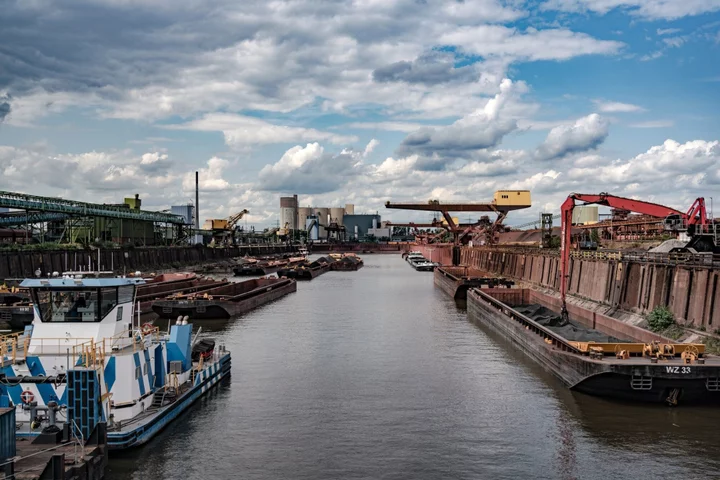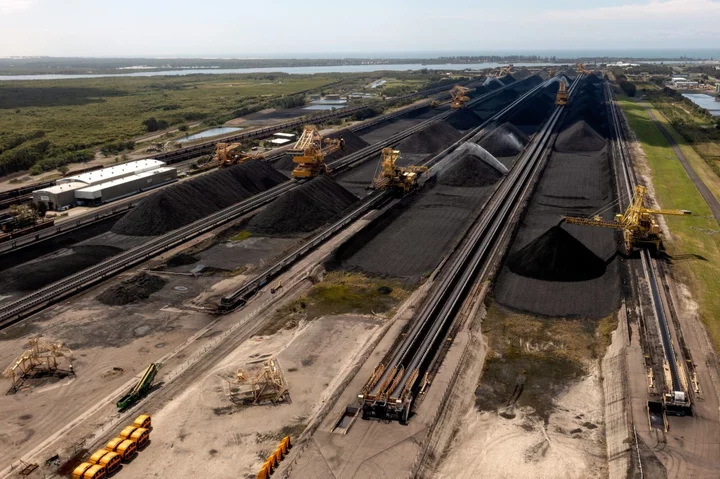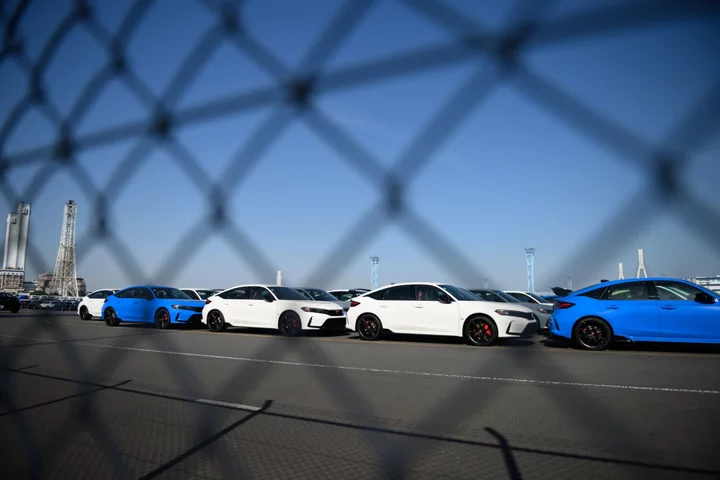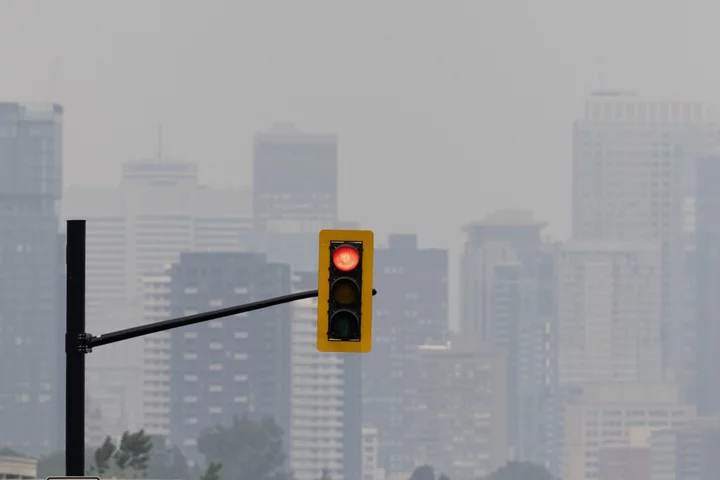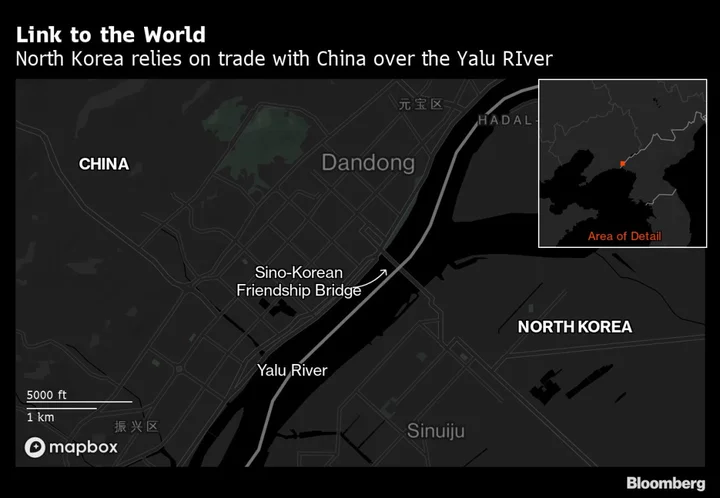The Rhine River has been a reliable shipping lane for centuries, helping spawn industrial giants along its banks. But those days are coming to an end, and the scramble is made all the more urgent as Germany’s government fails to keep pace.
With water regularly receding to levels that impede shipping from late summer through the fall, companies up and down Europe’s most important trade route are rushing to adapt, underscoring how the climate crisis is hitting even advanced industrial economies.
BASF SE is re-routing logistics to trains and trucks. Plastics maker Covestro AG has contingency plans that include shifting some production to Belgium. Manufacturers are stockpiling supplies, utilities are storing extra fuel, and freight operators have started overhauling fleets with barges able to navigate shallow water.
The costly and cumbersome workarounds are aimed at avoiding widespread shutdowns due to disruptions in the critical transport artery — a dilemma that’s becoming more frequent as warmer winters mean less snow to maintain levels during dry summer months.
After brutal heat waves scorched southern Europe, the river at Kaub, a key waypoint west of Frankfurt, has hit levels this summer that mean some ships could carry only about half of normal capacity. While recent rains have eased the strain, even small changes can have a major impact. A drop of 10 centimeters (four inches) means about 100 fewer tons can be transported per ship, according to Florian Röthlingshöfer, director of Swiss Rhine Ports.
“What we might experience today as the exception will become the norm in the future,” Christoph Heinzelmann, director of Germany’s Federal Waterways Engineering and Research Institute, said in an interview. “With that, more limitations will arise.”
Overhauling the Rhine’s fleet of 8,900 ships for shallow water could total around €90 billion ($99 billion). And that’s just part of the costs to keep commerce flowing. There’s extra inventories and the space to store them, as well as government plans to reengineer the river, which are slow in coming.
Initiatives have been in the works for years and include early-warning systems and dredging a tricky 50-kilometer stretch that runs from the baroque Biebrich palace near Mainz to just past Kaub and the legendary Lorelei cliffs — a project the German government estimates will cost €180 million.
After last year’s drought, Chancellor Olaf Scholz’s administration sought to speed up efforts, but that’s now stalled due to infighting and bureaucratic inertia, adding to challenges facing Europe’s largest economy.
Read More: Germany’s Economic Malaise Evokes ‘Sick Man of Europe’ Era
The Rhine snakes its way nearly 800 miles from the Swiss Alps through Germany’s industrial heartland before emptying into the North Sea at the Dutch port of Rotterdam. It conveys more than 10% of Swiss trade and about two tons per German resident every year. That’s now under threat.
In late summer, snow melt no longer plays a major role for the Rhine and that supply of water was exhausted even earlier this year, according to Dennis Meissner, a forecaster at the German Federal Institute of Hydrology. “So high temperatures are mainly a driver for low flow,” he said.
An initial warning sounded in 2018, when the Rhine reached historic lows and transport on the river all but ceased — shaving €5 billion off German industrial production. Since then, levels have more frequently constrained capacity. Last year, Germany recorded the lowest volume of trade on the Rhine and other inland waterways since at least 1990, according to the German statistics agency.
The river is largely irreplaceable for sites like BASF’s sprawling facility in Ludwigshafen. The world’s largest chemical plant — occupying 10 square kilometers along the river — loads and unloads about 15 barges a day, accounting for about 40% of its transport volume. BASF uses an early-warning system that predicts issues six weeks in advance. It’s increasingly looking to shift transport to rail and is adding loading points to be more flexible.
Germany’s largest steel mill is even more exposed. Located in Duisburg at the confluence of the Rhine and Ruhr rivers, Thyssenkrupp AG’s facility requires 60,000 tons of raw materials a day. Halting barges would require 2,000 trucks, and abandoning the Rhine entirely isn’t feasible, according to a company spokeswoman. River barges remain “the most efficient, economic and ecological mode of transport,” she said.
Covestro’s plants in the German state of North Rhine-Westphalia get a majority of their raw materials and convey about a third of their finished goods via the Rhine. The company has a task force that springs into action when water levels get critical. Measures include renting more ships to allow for lighter loads and shifting production to other locations in Germany and Belgium.
Read More: A River at Europe’s Heart Gives Riled Farmers a Climate Solution
Companies have little choice but to invest to secure operations. The main strategy is to horde supplies and build as much redundancy into logistics operations as possible. Freight companies are ordering redesigned barges like the Stolt Ludwigshafen. The 135-meter long ship, which was christened on BASF’s behalf in May, is broader than conventional versions and so can navigate low water more safely.
But costing at least €10 million each, it’s a pricey switch. And the transition is only just beginning. Freight operator HGK in Cologne operates 350 barges on the Rhine and other European rivers, but only four are low-water vessels with three more under construction.
There’s also limited capacity. Dutch shipbuilder De Gerlien van Tiem, which built two ships for Covestro, says its order books are full until the end of next year.
Political support isn’t likely anytime soon. Plans to ease Rhine shipping have been caught up in bickering among the three parties in Scholz’s ruling coalition.
Waterways haven’t yet been fully included in a law designed to accelerate the approval of crucial infrastructure projects because the Greens pushed back against the pro-business Free Democrats over concerns about the environmental impact of dredging. Without the legislation easing bottlenecks, the dredging of the key middle Rhine stretch won’t happen until after 2030 at the earliest, according to Germany’s inland shipping association BDB.
Deepening the shipping channels around Kaub remains one of Germany’s most important transport projects and the initiative still benefits from government efforts to set a four-year limit on certain approval processes, a spokesman for the transport ministry said in response to Bloomberg questions.
While Germany has vowed to increase inland shipping along with rail cargo to clean up its transport sector, it’s not backing that up. According to the government’s long-term spending plan, it expects to invest €270 billion in transport infrastructure by 2030 — nearly half is earmarked for roads and less than 10% for waterways.
In November last year — after the Rhine was again affected by drought — the transport ministry convened a so-called acceleration commission consisting of representatives from federal and state governments, Rhine-based manufacturers as well as environmental groups. Proposals were supposed to be presented by mid-2023, but are now expected in September.
In contrast to Germany’s slow approach, Switzerland has already carried out a dredging operation to ease access to its Rhine ports. The plan was anchored in a 2014 climate report, with approval granted in 2017 and the project completed in February 2019.
While Scholz’s coalition says it wants to take the lead on climate policy, it’s not following through fast enough, according to Claudia Kemfert, professor of energy economics at the DIW research institute in Berlin
“At the moment, no state acts with the necessary urgency — unfortunately not even Germany,” she said. “We have an enormous obligation because we are so emissions-intensive and are not living up to our responsibility of recognizing this climate emergency as real.”
--With assistance from Samuel Dodge, Demetrios Pogkas, Monica Raymunt, Paula Doenecke, Jack Wittels, Kamil Kowalcze and Priscila Azevedo Rocha.
Author: Petra Sorge, Wilfried Eckl-Dorna and Carolynn Look

